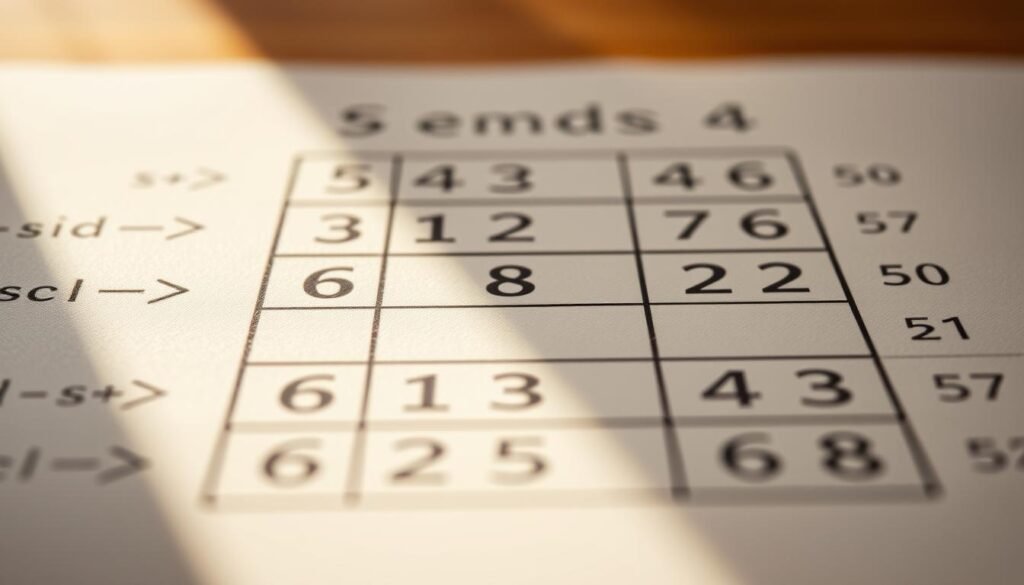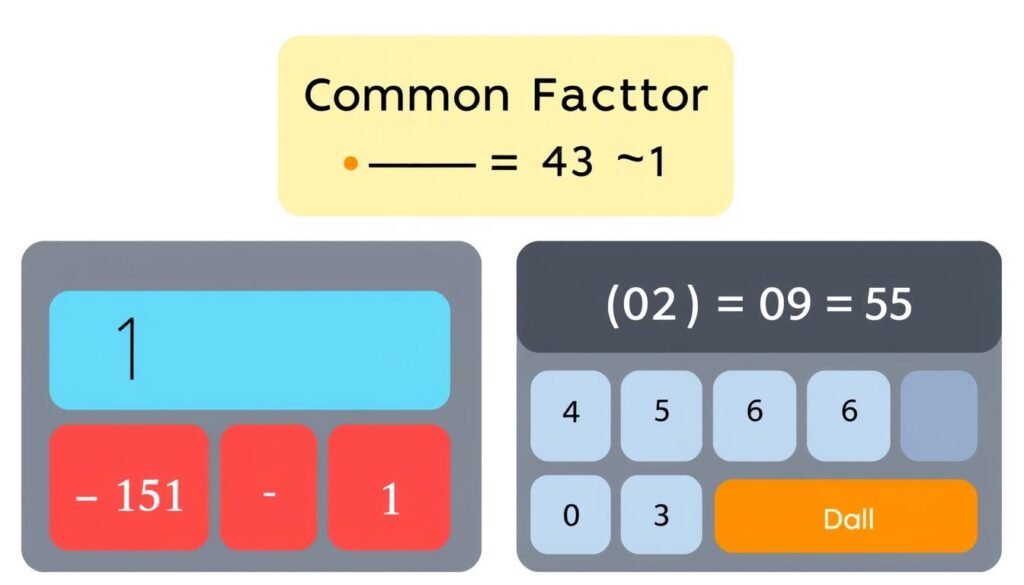Finding the greatest common factor between numbers is a crucial mathematical operation used in various contexts, from simplifying fractions to solving complex equations. Our calculator tool is designed to simplify this process, providing an efficient solution to identify factors between different numbers.
By using our calculator, users can easily determine the common factors of various numbers, eliminating the need for manual calculations. This not only saves time but also reduces the likelihood of errors. Our tool is equipped to handle different types of numbers and provides accurate results every time.
Key Takeaways
- Efficiently find the greatest common factor between different numbers.
- Simplify mathematical operations with our calculator tool.
- Accurate results for various types of numbers.
- Step-by-step solutions to understand the process.
- Applications in simplifying fractions and solving complex equations.
- Eliminates manual calculation errors.
Understanding Common Factors
In mathematics, identifying common factors is a fundamental skill that aids in solving complex equations. Common factors are numbers that divide evenly into two or more numbers without leaving a remainder. Understanding this concept is crucial for various mathematical operations.
What Are Common Factors?
Factors of a number are the numbers that can be multiplied together to get that number. For instance, the factors of 18 are 1, 2, 3, 6, 9, and 18. When comparing two or more numbers, the numbers that are factors of all the given numbers are called common factors. For example, the common factors of 18 and 27 are 1, 3, and 9. The greatest common factor (GCF) is the largest of these common factors, which in this case is 9.
The Importance of Finding Common Factors
Finding common factors is essential for simplifying fractions and solving algebraic equations. It helps in breaking down complex problems into simpler components, making it easier to solve them. The GCF is particularly useful in math for reducing fractions to their simplest form. Moreover, understanding common factors lays the foundation for more advanced mathematical concepts, such as divisibility and prime numbers.
By grasping the concept of common factors and the greatest common factor, we can simplify various mathematical operations and enhance our problem-solving skills.
Methods to Find Common Factors Manually
There are multiple manual methods for determining common factors, each with its own strengths. These methods are essential for understanding the underlying mathematics and for situations where a calculator is not available.
The Factoring Method
The factoring method involves listing all the factors of the numbers in question and identifying the common ones. This approach is straightforward and effective for smaller numbers.
Step-by-Step Process
To use the factoring method, start by listing all the factors of each number. For example, to find the common factors of 18 and 27, we list the factors of 18 (1, 2, 3, 6, 9, 18) and 27 (1, 3, 9, 27). The common factors are 1, 3, and 9.
Example Problems
Let’s consider another example: finding the common factors of 24 and 30. The factors of 24 are 1, 2, 3, 4, 6, 8, 12, 24, and of 30 are 1, 2, 3, 5, 6, 10, 15, 30. The common factors are 1, 2, 3, and 6. The greatest common factor (GCF) is 6.
Prime Factorization Method
The prime factorization method involves breaking down numbers into their prime factors. This method is particularly useful for larger numbers and provides a clear understanding of the number’s structure.
How to Break Down Numbers
To break down a number into its prime factors, we divide it by the smallest prime number (2) as long as it’s divisible, then move to the next prime number (3), and so on. For instance, the prime factorization of 18 is 2 × 32.
Worked Examples
For 27, the prime factorization is 33. To find the GCF of 18 and 27 using prime factorization, we identify the common prime factors (3) and their lowest powers (32 for 18 and 33 for 27), resulting in a GCF of 32 = 9.

Euclid’s Algorithm for Larger Numbers
Euclid’s Algorithm is an efficient method for finding the GCF of two numbers, especially useful for larger numbers. It involves repeatedly applying the division algorithm, swapping the remainder with the divisor until the remainder is zero.
The Process Explained
The process starts by dividing the larger number by the smaller one and then continuing with the smaller number and the remainder until the remainder is zero. The last non-zero remainder is the GCF.
Practical Examples
For example, to find the GCF of 182664 and 154875 using Euclid’s Algorithm, we perform a series of divisions: 182664 ÷ 154875 = 1 remainder 27789, 154875 ÷ 27789 = 5 remainder 15930, and so on, until we reach a remainder of zero. The GCF is the last non-zero remainder.
Using a Common Factor Calculator
Our common factor calculator is designed to simplify the process of finding common factors between two numbers.

How Common Factor Calculators Work
Common factor calculators operate using algorithms based on manual methods such as prime factorization and Euclid’s algorithm. These algorithms enable the calculator to efficiently list all factors for the input numbers and identify their common factors.
By automating the calculation process, our calculator saves time and reduces the likelihood of human error, especially when dealing with large numbers.
Step-by-Step Guide to Using Our Calculator
To use our common factor calculator, simply input the two numbers you’re interested in, and our tool will display the factors for each number as well as their common factors.
For example, if you input 54 and 72, the calculator will show that the common factors are 1, 2, 3, 6, 9, and 18.
Our calculator also identifies the greatest common factor (GCF), providing a comprehensive understanding of the numbers’ relationship.
Interpreting the Results
The results provided by our calculator include a list of all factors for each input number and the common factors between them.
Understanding these results can help in simplifying fractions, solving algebraic equations, and tackling real-world math problems.
By examining the factors and GCF, users can gain insights into the mathematical properties of the numbers they’re working with.
Practical Applications of Common Factors
Common factors play a crucial role in various mathematical contexts, from simplifying fractions to solving complex algebraic equations. The significance of common factors is evident in multiple areas of mathematics and real-world problem-solving.
Simplifying Fractions
One of the primary applications of common factors is in simplifying fractions. By dividing both the numerator and denominator by their greatest common factor (GCF), fractions can be reduced to their simplest form. For instance, the fraction 18/27 can be simplified to 2/3 by identifying and dividing by the GCF of 9. This process makes fractions easier to understand and work with in various mathematical operations.
Solving Algebraic Equations
Common factors are also instrumental in solving algebraic equations. By factoring out the greatest common factor from algebraic expressions, such as 6x² + 9x, we can simplify them to 3x(2x + 3), making it easier to find solutions. This technique is particularly useful when working with polynomial expressions and systems of equations.
Real-World Math Problems
The application of common factors extends to real-world math problems, including measurement conversions, time calculations, and financial mathematics. Professionals in fields like engineering, finance, and computer science frequently use common factors in their work. For example, in geometry, common factors relate to concepts such as angles measured in degrees and radians, and calculations involving circles and trigonometric functions.

Conclusion
The concept of common factors is fundamental to mathematics, and using a Common Factor Calculator can simplify the process. Throughout this article, we’ve explored the importance of understanding common factors and the various methods to find them, including manual calculations and using our calculator tool.
We’ve highlighted the practical applications of common factors in simplifying fractions, solving algebraic equations, and addressing real-world mathematical problems. By mastering this concept, individuals can enhance their problem-solving skills and tackle complex mathematical challenges with ease.
Our Common Factor Calculator is designed to provide an efficient and accurate solution, offering a user-friendly interface and comprehensive steps. We encourage readers to utilize this tool for their mathematical needs and explore other related mathematical concepts, such as least common multiples and prime factorization.
FAQ
What is the greatest common factor (GCF) of two numbers?
The GCF is the largest positive integer that divides both numbers without leaving a remainder. We use it to simplify fractions and solve algebraic expressions.
How do I find the GCF of two numbers manually?
We can find the GCF manually by listing the factors of each number, using the prime factorization method, or applying Euclid’s algorithm for larger numbers.
What is the difference between a factor and a multiple?
A factor is a number that divides another number exactly, whereas a multiple is the product of a number and an integer. Understanding the difference is crucial for simplifying math problems.
Can I use a GCF calculator for more than two numbers?
Our GCF calculator is designed to find the GCF of two numbers. For more than two numbers, we need to find the GCF of the first two numbers and then find the GCF of the result with the next number, and so on.
How does prime factorization help in finding the GCF?
Prime factorization involves breaking down numbers into their prime factors. The GCF is then found by taking the product of the lowest powers of common prime factors. This method is efficient for finding the GCF of large numbers.
Are there any real-world applications of finding the GCF?
Yes, finding the GCF has numerous practical applications, such as simplifying fractions, solving algebraic equations, and resolving real-world math problems involving ratios and proportions.

